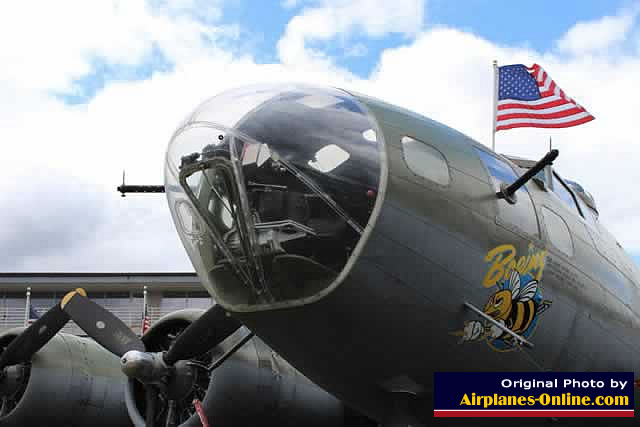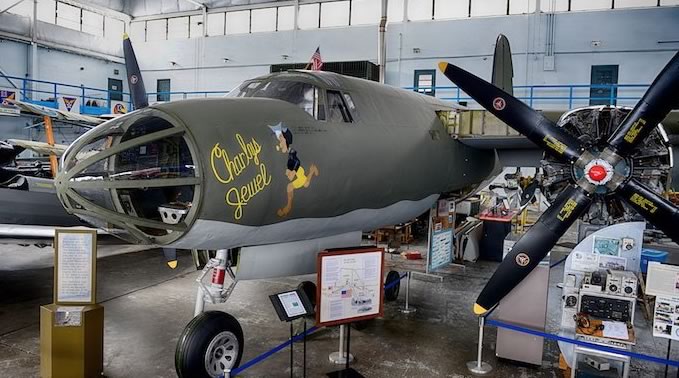U.S. Army Air Force Bombers of World War II
The United States manufactured about 300,000 military aircraft just prior to, and during, World War II. Included in this number was large quantities of numerous bomber aircraft. Production totaled 97,810 bombers.
Featured below are the dominant military bombers used by the United States during World War II.
B-17 Flying Fortress
 |
The Boeing B-17 Flying Fortress four-engine heavy bomber is one of the most famous, and successful, airplanes ever built. The B-17 received the name "Flying Fortress" from a Seattle news reporter who commented on its defensive firepower, and said "It's a Flying Fortress".
The original intent for the B-17 was the protection of the U.S. mainland from invasion fleets. In 1934, the Boeing Aircraft Company of Seattle, Washington, began construction of a four-engine heavy bomber. Known as Boeing Model 299, it first took flight on July 28, 1935. Delivery of these first production models was between January 11 and August 4, 1937.
B-17s served in every World War II combat zone. The aircraft is best known for daylight strategic bombing of German industrial targets. The B-17 flew mostly out of England, equipping 26 of the 40 bombardment groups of the 8th Air Force.
Following the end of World War II, the B-17 was quickly phased out of use as a bomber and the Army Air Forces retired most of its fleet. Production ended in May 1945 and totaled 12,731.
... about the B-17, its specifications, history, production, survivors, and photographs
B-24 Liberator
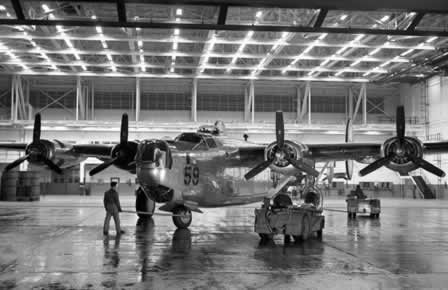 Rolling out a newly built B-24 Liberator at the Ford Willow Run Plant |
The Consolidated B-24 Liberator was a 4-engine, twin-tail heavy bomber designed by Consolidated Aircraft of San Diego. Its first flight was on December 29, 1939, and it began service in 1941.
The B-24 was a more modern design than the Boeing B-17 Flying Fortress, with a higher top speed, greater range, higher ceiling, and a heavier bomb load. But the B-24 was more difficult to fly, with heavy control forces and poor formation-flying characteristics. The positioning of the fuel tanks also made the plane prone to fire. The high fuselage-mounted wings also made it more difficult to survive crash landings on land or water.
A total of 18,493 Liberators were built, more than any other aircraft in World War II.
The Willow Run manufacturing plant, located between Ypsilanti and Belleville, Michigan, was constructed during World War II by the Ford Motor Company for the mass production of the B-24 Liberator. On October 1, 1942, the first plane was completed and christened "The Spirit of Ypsilanti."
The Willow Run Airport, with six runways to test planes, was also completed in 1942. At the peak of production, the assembly line was producing a Liberator an hour. On June 28, 1945 production ceased, after 8,685 planes had been manufactured.
B-25 Mitchell
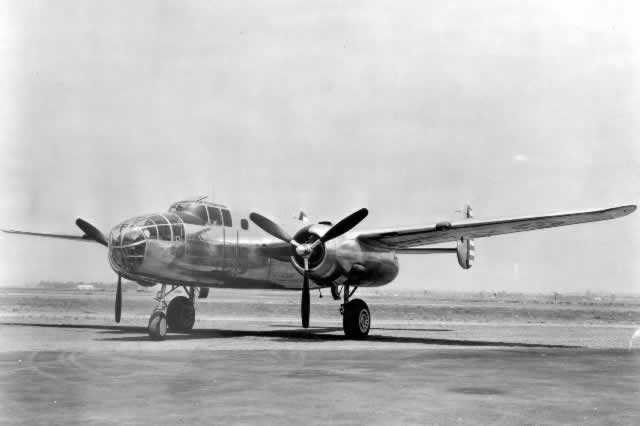 Early production model of the B-25 |
The B-25 Mitchell was a twin-engined medium bomber used in World War II, and manufactured by North American Aviation. The B-25 was named in honor military aviation pioneer General Billy Mitchell.
The B-25 first flew on August 19, 1940, and the U.S. Army Air Corps accepted the first five B-25s in February of 1941.
The B-25 saw duty in every combat area being flown by the Dutch, British, Chinese, Russians and Australians in addition to U.S. forces.
Although the B-25 was originally intended for level bombing from medium altitudes, it was used extensively in the Pacific area for bombing Japanese airfields from treetop level and for strafing and skip bombing of enemy shipping.
The plane is well remembered for its role in the Doolittle Raid, on April 18, 1942, the first air raid by the United States to strike the Japanese homeland during World War II.
Of the 9,890 B-25s built during WWII, there are more than one hundred surviving aircraft around the world, most of which are located in the United States.
... about the B-25 Mitchell, its specifications, history, production and photographs
B-26 Marauder
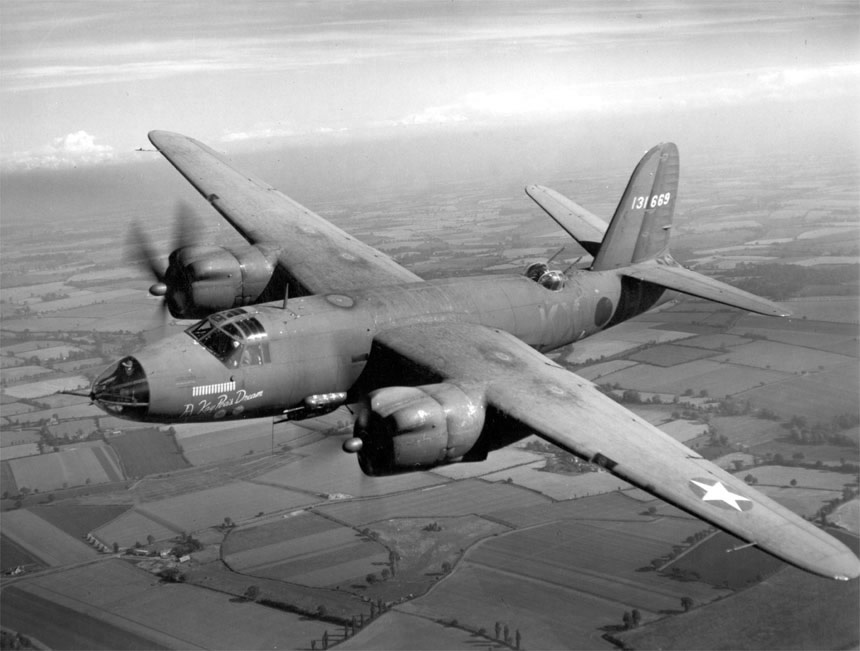 Martin B-26 Marauder in flight |
The Martin B-26 Marauder was an American twin-engined medium bomber that was designed and built by the Glenn L. Martin Company. The bomber was assembled at plants in Baltimore, Maryland, and Omaha, Nebraska.
The B-26 saw extensive service during World War II. First used in the Pacific Theater in early 1942, it was also used in the Mediterranean Theater and in Western Europe.
A total of 5,288 Marauders were built between 1941 and 1945. After the Marauder was retired, the unrelated Douglas A-26 Invader assumed the "B-26" designation, which led to confusion between the two aircraft.
... about the B-26 Marauder, its specifications, history, production and photographs
B-29 Superfortress
 Boeing B-29 "Enola Gay" |
Boeing began work on a pressurized long-range bomber in 1938. In December 1939, the Army Air Corps issued a formal specification for a so called "superbomber", capable of delivering 20,000 lbs of bombs to a target 2,667 miles distant, at a speed of 400 mph.
The B-29 featured the first ever fully pressurized nose and cockpit in a bomber; an aft area for the crew was also pressurized. Since the bomb bays were not pressurized, a pressurized tunnel was devised to connect the fore and aft crew areas. A retractable tail bumper was provided for tail protection during nose-high takeoffs and landings.
In wartime, the B-29 was capable of flight up to 31,850 feet at speeds of 350 mph. Designed as a high-altitude daytime bomber, the B-29 flew more low-altitude nighttime incendiary bombing missions.
The B-29 is most often remembered by many for two missions that occurred in August of 1945, over the Japanese cities of Hiroshima and Nagasaki that lead to a quicki end of World War II.
Colonel Tibbets piloted the B-29 "Enola Gay" (Serial Number 44-86292) on August 6, 1945, and dropped "Little Boy" over Hiroshima, Japan. He had named the plane after his mother, Enola Gay Tibbets. The plane had been built at the Glenn Martin plant in Omaha, Nebraska.
Three days later the "Fat Man" was dropped on Nagasaki by the B-29 "Bockscar".
A total of 3,970 production B-29s were built at several plants across the U.S.
... about the B-29 Superfortress, its specifications, history, production and photographs
B-32 Dominator
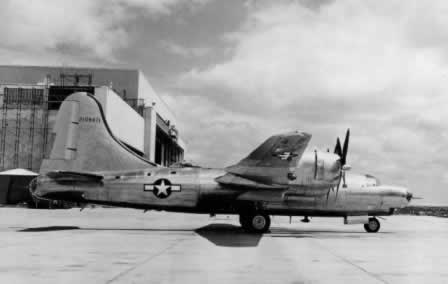 Consolidated B-32-1-CF Dominator (S/N 42-108471) |
The Consolidated B-32 Dominator was a four-engined heavy bomber ordered by the Army Air Force at the same time as the Boeing B-29 Superfortress. In reality, the B-32 was a fall-back aircraft in the event that the complex, technology-laden B-29 did not meet its expectations as the nation's premier heavy bomber of World War II.
The Dominator's original design was similar to Consolidated's existing bomber, the B-24 Liberator, in that it used twin fins and a large Davis-type wing; but it featured with a longer, rounder fuselage and a rounded nose.
Although the B-32 was designed to the same specifications as the Boeing B-29, considerably more development was necessary by Consolidated to meet the USAAF's specifications. Pressurization and remote control of the gun turrets were abandoned and the twin-ruddered B-24-type tail was replaced in 1944 by a very large B-29-type single fin and rudder.
In the end, the B-32's testing and production problems resulted in limited availability, and consequently the bomber saw little action during WWII. An airplane conceived in 1939 was not ready for war action until mid-1945. The success of the B-29 Superfortress also gave lesser importance to the B-32 program.
A total of 300 B-32s were ordered, but only 118 were delivered to the USAAF. A total of 130 were flyable, and 170 more cancelled.
... about the B-32 Dominator, its specifications, history, production and photographs
Photographs of World War II Bombers
B-17F "Boeing Bee" - S/N 42-29782 - in Seattle, WA |
|
Consolidated B-24J Liberator "Witchcraft" (S/N 44-44052) of the Collings Foundation |
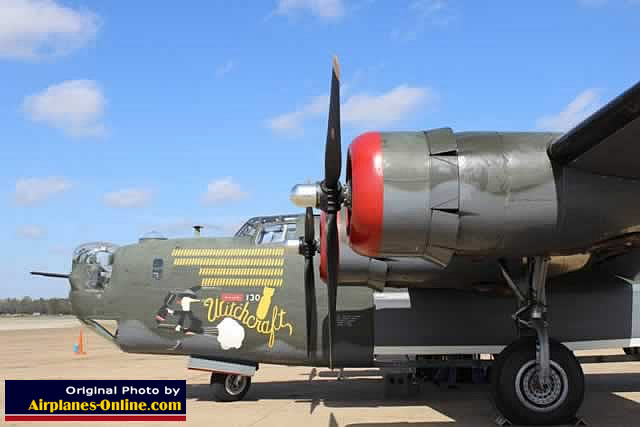 |
B-25J Mitchell "Lazy Daisy Mae" S/N 44-86891 on display at the Castle Air Museum in Atwater, California |
 |
B-26 Marauder "Charley's Jewel" S/N 40-1459 at the MAPS Air Museum in Akron, Ohio |
|
B-29 Superfortress "Straight Flush", S/N 4486408, at the Hill Aerospace Museum in Utah (Staff Photo) |
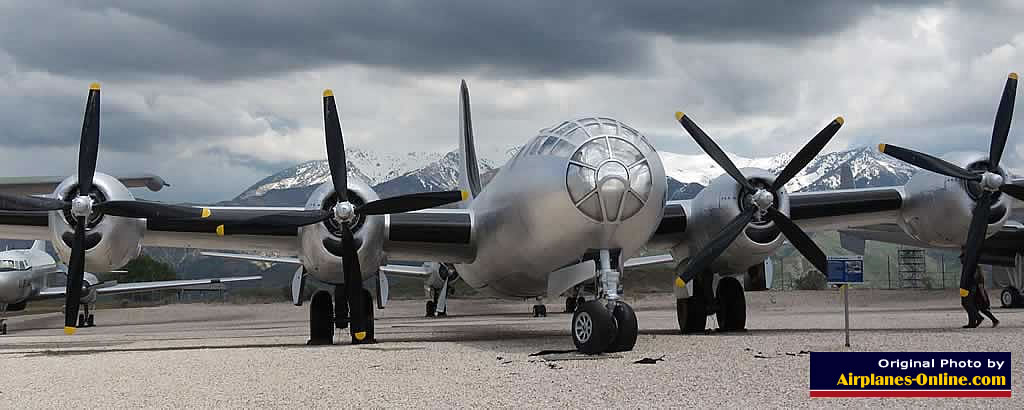 |


